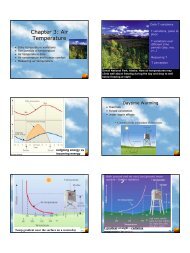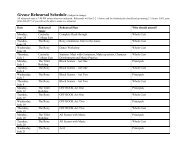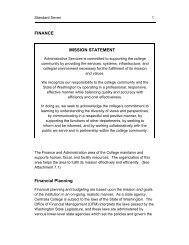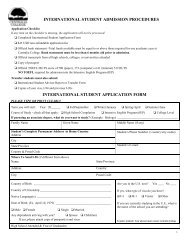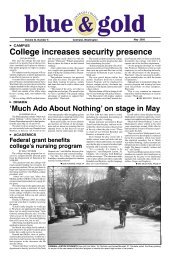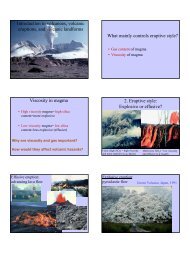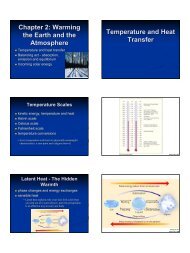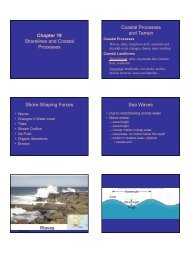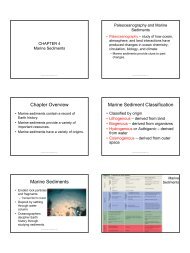Sedimentary Rocks Weathering Mechanical Weathering Types of ...
Sedimentary Rocks Weathering Mechanical Weathering Types of ...
Sedimentary Rocks Weathering Mechanical Weathering Types of ...
- No tags were found...
Create successful ePaper yourself
Turn your PDF publications into a flip-book with our unique Google optimized e-Paper software.
LithificationSedimentsDeposition<strong>Sedimentary</strong> <strong>Rocks</strong><strong>Weathering</strong>The sediments that make up sedimentary rocks are produced by:<strong>Mechanical</strong> & Chemical <strong>Weathering</strong>TransportErosion<strong>Weathering</strong>http://www.teachnet-lab.org/ps101/bglasgold/rocks/EFCycleP2.gif<strong>Types</strong> <strong>of</strong> mechanical aka physicalweathering<strong>Mechanical</strong> <strong>Weathering</strong>• unloading – rx expand when overburden lessened• frost wedging – H 2 O expands 9% to ice• insolation – solar heating expansion• salt crystals• root wedging• seismic deformationChemical <strong>Weathering</strong>big point: someminerals are morestable than others…MineralStabilityhydrolysis, oxidation,dissolution, dehydration,solutioning, bio-chemicalweathering1
Products <strong>of</strong> <strong>Weathering</strong>Erosion & Transport• Lithic (Rock) Fragments(granite, basalt,schist, etc.)• Dissolved Ions(Calcium, Potassium, Sodium, etc.)• Rust Minerals (Hematite, Goertite, etc.)• Clay Minerals(Bentonite, Montmorillonite, etc.)• Residual Minerals(Quartz, Orthoclase, Muscovite, etc.)WaterWindIceGravityCommon Depositional EnvironmentsMarine shoreline and near-shoreenvironmentsSedimentLithificationCementationTypical Cements:•Calcite•Quartz•Iron oxideRock2
<strong>Types</strong> <strong>of</strong> <strong>Sedimentary</strong> <strong>Rocks</strong><strong>Sedimentary</strong> <strong>Rocks</strong>IdentificationDetrital or clastic <strong>Rocks</strong>Chemical <strong>Rocks</strong>Note: Use many <strong>of</strong> the same terms to describesediments & sedimentary rocks.Only difference is lithification!vs.Difference: TextureDetrital (Clastic Texture)vs.Chemical (Crystalline Texture)Detrital Rock CompositionDetrital <strong>Rocks</strong>• Lithic Fragments• Quartz• Clay Minerals• Fossil Fragments• Rust Minerals• Orthoclase• Muscovite / BiotiteClastic Texture• Grain Size• Grain Sorting• Grain Rounding• Sediment MaturityDetrital Rock Texture•Gravel2mm•Sand1/16 mm•Mud - Silt1/256 mm•Mud - ClayGrain Size3
Detrital Rock Names(Based Primarily on Grain Size)SortingGravel -Sized:ConglomerateSand Sized: SandstoneMud-Sized:MudstoneSiltstoneShaleGravel Sized Detrital <strong>Rocks</strong>(Subdivided Based on Grain Roundness)ConglomerateBrecciaMaturityMature•Well Sorted•Well Rounded•All QuartzImmature•Poorly Sorted•Angular grains•Mixed Compositionincluding clayQuartz SandstoneLithic SandstoneSandstones(Subdivided basedon maturity)Arkose (Sandstone)Greywacke4
Sandstones Under a ScopeDetrital <strong>Sedimentary</strong> Rock IDChemical Rock TextureCrystalline Texture• Coarse• FineChemical <strong>Sedimentary</strong> <strong>Rocks</strong>(Names based primarily on composition)Composition• Calcite• Quartz (silica)• Halite• Gypsum• “Carbon” / PlantRemainsBasic Rock Name• Limestone• Chert• Rock Salt• Rock Gypsum• Peat or CoalCrystallineLimestoneChemical <strong>Rocks</strong>(Names based mainly on composition)LimestonesChemical <strong>Rocks</strong> (cont.)EvaporitesFossiliferous LimestoneChertRock SaltChalkRockGypsumCoal5
<strong>Sedimentary</strong> <strong>Rocks</strong>InterpretationsWhat do <strong>Sedimentary</strong> <strong>Rocks</strong> Record?•Source <strong>of</strong> sediment•Erosion and Transport Agent•Distance <strong>of</strong> Transport•Depositional Environment•Paleogeography/Tectonic SettingChemical <strong>Sedimentary</strong> Rock IDInterpretation <strong>of</strong> CompositionDetrital <strong>Rocks</strong>:• Source <strong>of</strong> sediment• Exposure to <strong>Weathering</strong>(Distance <strong>of</strong> Transport)(Type <strong>of</strong> Climate)Note About Detrital RockColor & Composition• Grain SizeSmaller is <strong>of</strong>ten darker• CompositionCarbon - black or brownQuartz - tan, clear, whiteOrthoclase – orange or pink• Depositional EnvironmentIron on land - redIron in deep, oxygen poor water - greenDetrital Rock Names(Based Primarily on Grain Size)Interpretation: Grain SizeGravel -Sized:ConglomerateSand Sized: Sandstone• Gravel• Sand• High Energy• River, Beach• River, Beach, Desert• Silt• Delta, Shallow OceanMud-Sized:Mudstone• Clay• Low Energy• Deep Ocean, Lake,SwampSiltstoneShale6
Interpretation: SortingClast Supported Conglomerate(River Deposits)Interpretation:Poorly SortedWell SortedTransport AgentGravity and Glaciers (and Rivers)Water and WindMatrix Supported Conglomerate(Glacial/Landslide Deposits)Interpretation: Grain Roundness2.2 Gyr Conglomerate“Modern”Glacial SedimentsShortInterpretation:Distance <strong>of</strong> TransportFarLimestoneFormation <strong>of</strong> LimestoneCrystallineLimestoneCalcite Precipitates inWarm WaterWater Under Low Pressure (Shallow)Fossiliferous LimestoneOrIt is secreted by biological organismsClams, Mussels, Scallops, etc.CoralsForaminiferaChalk7
Limestone Represents:Shallow Tropical OceanChalk(Foraminifera)Black SeaTravertine(Limestone)Black SeaChert (Flint, Jasper, Agate…)Diatom SkeletonsChemical sed. rk formedvia silicious ooze in thedeep sea. Source <strong>of</strong> silica= tests (tiny shells) <strong>of</strong>radiolarians and diatoms(which are made <strong>of</strong> silica)Radiolarians8
Evaporites:Bonneville Salt Flats, UtahChertRepresentsRockGypsumRock SaltDeep OceanIsolated,Arid,SaltySea/LakePeat and CoalSwamp, BogCoal beds in Puget Group sedimentary rocks near Ashford<strong>Sedimentary</strong> features andstructures• beds• crossbeds• ripple marks• graded beds• fossils• mud cracks• raindrop imprints• etcChannel fill~315 MaSharon Conglomerate, Cuyahoga River valley,Ohio9
Crossbedded sandstonedune depositionby wind!Planar cross bedsSharon Conglomerate,lower PennsylvanianAge (~315 Ma),Cuyahoga River valley,Ohio; interpreted as abraided streamsedimentaryenvironment (lens cap~52 mm) – dunedeposition by water!Zion National Park. Festooned cross beds deposited by wind.How crossbeds form—migrating dunes!Turbidity currentsaD:\digital_content\animations_library\0009.swf10
Modern mudcracksAncient mudcracks in shalemodern mud cracks,Ceres Road 2007flood-deposited mudsCurrent ripples in wet sediment,Baja CARipple marks in sandstone, CapitolReef National Park, UtahPat Pringle, photoRipple marks in tilted Puget Group sedimentary rocks<strong>of</strong> Eocene age near Wilkeson WA11
Fossil shells in sandstone, CAFossil fish from Eocene Green River Shale in westernWyomingFossil metasequoia leaf from rocksseveral miles east <strong>of</strong> Packwood,Oligocene ageLithologic Indicators <strong>of</strong> Climatehttp://www.scotese.com/legend.htmdipping beds in CentraliaCoal Mine, view to southfossils from SkookumchuckFormation12
Photo donated by Larry McMIllanhttp://www.ci.tenino.wa.us/TeninoQuarry1_small.jpgEocene McIntosh Formation:Tenino Sandstoneoutcrop along rr tracks near Chehalis R., Galvin WARock Units• FORMATION-– Extensive enough to show on a map– Distinctive from neighboring rock units– Named locally• CONTACTS– <strong>Sedimentary</strong> contacts – bounding surfacesbetween two sedimentary unitsGrand Canyon – an awesome place to see strata!Monument CreekGrand CanyonThe great unconformityTrack <strong>of</strong> 1984 debris flowBob Webb, photo, 198614
Granite Rapid, Grand CanyonBob volcanologist Webb, photo, 1986 for scale15





